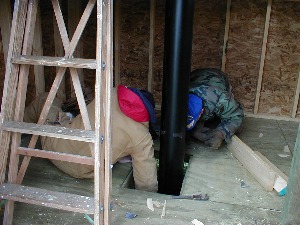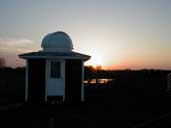

To prepare the final resting place for the observatory, I had to construct a solid concrete footing extending below the frost line for the heavy steel pier. The pier would attach to the top of the footing via 4 anchor bolts set into the concrete. At the center of the building’s subfloor there is a hole through which the pier projects up into the center of the dome. The first photo (taken nearly 10 years ago) shows Bryan Healy and I installing the pier through the subfloor hole in Grinnell. The pier had to be the correct height to allow the telescope to operate uninhibited when assembled. Before setting the concrete I really needed to know the height of the building’s subfloor above the ground. If the anchor bolts were too high or too low the pier height could cause problems for the telescope’s pointing capability. The building weighs over 3000 lbs so moving it into place in order to take measurements was not feasible. I consulted an engineering-minded friend named Tom Moorhead who suggested installing two parallel support beams to rest the building on. The beams would provide a smoother level surface than the ground. The idea was simple and once the beams were in place I could determine the height of concrete footing relative to the beams. It was time for the shovel…

I dug a central hole for the pier footing 36” in diameter and 36-40” deep. I then dug four more holes for 8” diameter concrete footings to support the parallel beams. When the concrete posts were set, I installed 4 x 6” beams oriented East-West on either side of the hole approximately 7 feet apart. I later bridged the beams with 4 x 4” posts to inhibit twisting under the heavy load as the building was positioned. It was time to set the concrete pier footing but then the rains came…
As bad luck would have it the central hole happened to be in an unobvious drainage spot. Even a small shower flooded the hole with water and that summer we had torrential rains. From July to mid-October I recall emptying that darn hole 6-7 times. I even sandbagged it in a futile effort to keep the water out. The miserable cycle reminded me of Bill Murray in the movie Ground Hog’s Day – the hole just kept filling back up. Eventually a long run of beautiful weather set in and I managed to set over 600 lbs of concrete with the anchor bolts at just the right height. Also the ground hardened enough that I was able to use my tractor to drag the building alongside the support beams bringing it within 10 feet of its new perch. Success! At long last, it was time for that rough terrain forklift…
Unfortunately Bryan Healy, who offered to operate the forklift, was busy the weekend I chose to move the building. Given the weather that summer I wasn’t taking any nice weekends for granted. We couldn’t postpone it. Bryan graciously contacted Larry Ashing who was more than happy to come over from Grinnell to run the forklift. This was fitting as Larry helped set the pier in my Grinnell observatory. The weather forecast was perfect on Saturday, October 10th so I rented the forklift and called on Larry. When he arrived he told me he’d never operated a rough terrain forklift. “Give me a second…”, he said while hopping into the driver’s seat. He started up the engine, tweaked a few controls, grinned broadly and gave me the thumbs up. He put forklift in gear, headed down the hill and we got right to work.
It took about two hours to set the building on the beams. Larry brought lifting straps and other gear I never would have thought of. He expertly worked the forklift to swing the building one side at a time onto the beams. Once safely on, he made inch by inch adjustments to position the building over the concrete footing. To make the final adjustments, I stood in the building sighting the anchor bolts through the hole in the subfloor. I recall Larry grinning the whole time he worked. He later told me, “That forklift is pretty handy…I wish I had one!”.
With the building set we were ready to install the big steel pier. I had to run up the hill to grab a couple large wrenches to fasten the pier to the footing’s anchor bolts. When I headed back down the hill I had to stop and take a picture of the scene. Larry had the pier suspended above the building within a couple inches of center. He lowered it through the subfloor with ease and I was able to muscle its mating collar onto the anchor bolts and secure it. The day’s (umm - year’s) work was done!
What a great feeling it was to finally have that pier pointing skyward again! I can’t thank Larry, Bryan and Tom enough for the inspiration and help. Although this is the final chapter of observatory move the story is really just beginning. In my garage behind a pile of Grinnell relocation remnants is a disassembled Home Dome. In my basement is a recently upgraded mount, a stack of telescope components, cameras and other astronomical goodies. Surely there’re a few more tales to tell --wouldn’t you think?